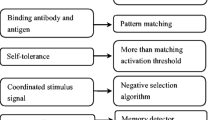Abstract
The Negative Selection Algorithm (NSA) and clonal selection method are two typical kinds of artificial immune systems. In this paper, we first introduce their underlying inspirations and working principles. It is well known that the regular NSA detectors are not guaranteed to always occupy the maximal coverage of the nonself space. Therefore, we next employ the clonal optimization method to optimize these detectors so that the best anomaly detection performance can be achieved. A new motor fault detection scheme using the proposed NSA is also presented and discussed. We demonstrate the efficiency of our approach with an interesting example of motor bearings fault detection, in which the detection rates of three bearings faults are significantly improved.










Similar content being viewed by others
Explore related subjects
Discover the latest articles, news and stories from top researchers in related subjects.References
Goldsby GA, Kindt TJ, Kuby J, Osborne BA (2003) Immunology, 5th edn. W. H. Freeman and Company, New York
de Castro LN, Timmis J (2002) Artificial immune systems: a new computational intelligence approach. Springer, London
Dasgupta D, Attoh-Okine N (1997) Immunity-based systems: a survey. In: Proceedings of IEEE international conference on systems, man, and cybernetics. Orlando, pp 369–374
Dasgupta D, Nino F (2009) Immunological computation: theory and applications. Auerbach Publications, Boca Rato
Forrest S, Perelson AS, Allen L, Cherukuri R (1994) Self-nonself discrimination in a computer. In: Proceedings of IEEE symposium on research in security and privacy. Los Alamos, pp 202–212
Dasgupta D, González F (2002) An immunity-based technique to characterize intrusions in computer networks. IEEE Trans Evol Comput 6(3):281–291. doi:10.1109/TEVC.2002.1011541
Dasgupta D, Forrest S (1995) Tool breakage detection in milling operations using a negative selection algorithm. University of New Mexico, Albuquerque
González F (2003) A study of artificial immune systems applied to anomaly detection. University of Memphis, Memphis
Ayara M, Timmis J, de Lemos R, de Castro LN, Duncan R (2002) Negative selection: how to generate detectors. In: Proceedings of the 1st international conference on artificial immune systems. Canterbury, pp 89–98
González F, Dasgupta D, Nino LF (2003) A randomized real-value negative selection algorithm. In: Proceedings of the 2nd international conference on artificial immune systems. Edinburgh, pp 261–272
Gao XZ, Ovaska SJ, Wang X, Chow MY (2008) A neural networks-based negative selection algorithm in fault diagnosis. Neural Comput Appl 17(1):91–98. doi:10.1007/s00521-007-0092-z
Gao XZ, Ovaska SJ, Wang X, Chow MY (2007) A hierarchical optimization scheme for negative selection algorithm detectors in motor fault detection. In: Proceedings of the IEEE three-rivers workshop on soft computing in industrial applications. Passau, pp 163–169
Gao XZ, Ovaska SJ, Wang X (2007) Particle swarm optimization of detectors in negative selection algorithm. In: Proceedings of the IEEE international conference on systems, man, and cybernetics. Montreal, pp 1236–1242
Gao XZ, Ovaska SJ, Wang X (2008) A GA-based negative selection algorithm. Int J Innov Comput Inf Contr 4(4):971–979
Gao XZ, Ovaska SJ, Wang X (2008) Re-editing and censoring of detectors in negative selection algorithm. In: Proceedings of the 2nd international and interdisciplinary conference on adaptive knowledge representation and reasoning. Porvoo, pp 23–30
Wang X, Gao XZ, Ovaska SJ (2004) Artificial immune optimization methods and applications—a survey. In: Proceedings of the IEEE international conference on systems, man, and cybernetics. Hague, pp 3415–3420
de Castro LN, von Zuben FJ (2002) Learning and optimization using the clonal selection principle. IEEE Trans Evol Comput 6(3):239–251. doi:10.1109/TEVC.2002.1011539
Ada GL, Nossal GJV (1987) The clonal selection theory. Sci Am 257(2):50–57
Poli R, Langdon WB (2002) Foundations of genetic programming. Springer, Berlin
Yoo J, Hajela P (1999) Immune network simulations in multicriterion design. Struct Optim 18(2–3):85–94. doi:10.1007/BF01195983
Wang X, Gao XZ, Ovaska SJ (2007) A hybrid optimization algorithm based on ant colony and immune principles. Int J Comput Sci Appl 4(3):30–44
Frank PM (1990) Fault diagnosis in dynamic systems using analytical and knowledge-based redundancy—a survey and some new results. Automatica 26(3):459–474. doi:10.1016/0005-1098(90)90018-D
Chow MY (1997) Methodologies of using neural network and fuzzy logic technologies for motor incipient fault detection. World Scientific Publishing Co. Pte. Ltd, Singapore
Li B, Chow MY, Tipsuwan Y, Hung JC (2000) Neural-network-based motor rolling bearing fault diagnosis. IEEE Trans Ind Electron 47(5):1060–1069. doi:10.1109/41.873214
Acknowledgments
This research work was funded by the Academy of Finland under Grants 214144 and 124721. The authors would like to thank the anonymous reviewers for their insightful comments and constructive suggestions that have improved the paper.
Author information
Authors and Affiliations
Corresponding author
Appendix
Appendix
Detectors generated in the regular NSA:
Clonal optimized detectors for single bearings fault detection:
Clonal optimized detectors for dual bearings fault detection:
Clonal optimized detectors for triple bearings fault detection:
Rights and permissions
About this article
Cite this article
Gao, X.Z., Ovaska, S.J., Wang, X. et al. Clonal optimization-based negative selection algorithm with applications in motor fault detection. Neural Comput & Applic 18, 719–729 (2009). https://doi.org/10.1007/s00521-009-0276-9
Received:
Accepted:
Published:
Issue Date:
DOI: https://doi.org/10.1007/s00521-009-0276-9





